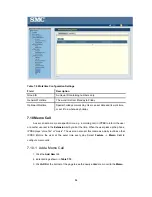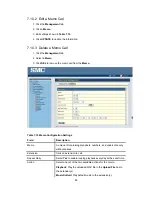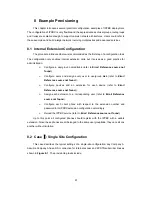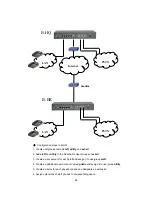
93
10. Create a PSTN trunk with ID “1”, port “1-2”, choose pstn-out as outbound routegroup,
do not select any DID of extension, and select
ext-all
as the usergroup of privilege.
11. Return to usergroup configuration. For usergroup
staff
, click
pstn1
in Associated
Trunks, and select
utility
in Reachable User Group; while for usergroup
utility
, only select
staff
in Reachable User Group.
12. Reload the IPPBX Service.
8.3 Case
Ⅱ
: Two sites Configuration
This case describes the typical settings of a two-site configuration; say Company B
headquarters B-HQ and its branch B-BR located in another country. Assume each site has a
DSL connection for Internet access. B-HQ has 4 PSTN subscriber lines and B-BR has 2 lines
as shown in
Figure 8-2
. The provisioning tasks include:
!
Both sites have staff phones in cubes and offices and utility phones in public
areas.
!
Each phone has one extension. A utility phones can call extensions within the
site it is in only, while the staff phones can call any extension in both sites
without limitation. B-HQ has extensions 1XX and B-BR has extensions 2XX.
!
Calls between B-HQ and B-BR use private SIP trunks across Internet. IPPBX
at B-HQ has a static IP address, 64.1.0.1 and IPPBX at B-BR has a static IP
address, 222.44.0.1.
!
Only staff phones can call out to PSTN with a prefix 9.
!
B-HQ staff phones call out starting with 90118621 will relay to B-BR through
the SIP trunk and then hop off to PSTN in B-BR. Similarly, B-BR staff phones
call out starting with 9001408 will relay to B-HQ for PSTN hop-off.
!
Incoming PSTN calls are answered by auto attendant and could be
transferred to any extension.
Summary of Contents for PBX10 FICHE
Page 1: ...SMCPBX10 TigerVoIP IP PBX Telephony System USER GUIDE TM...
Page 2: ......
Page 132: ...SMCPBX10...


































